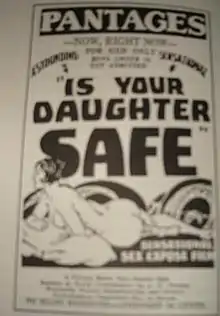Is Your Daughter Safe?
Is Your Daughter Safe?, also known as The Octopus, was an early silent exploitation film produced and directed by S. S. Millard. Written by Max Abramson, it was originally released in 1927 and presented around the United States in the following years.
| Is Your Daughter Safe | |
|---|---|
 An undated poster for the movie.[1] | |
| Directed by | S. S. Millard |
| Produced by | S. S. Millard |
| Written by | Max Abramson |
| Starring | Vivian Winston Jerome Young Henry Roquemore Georgia O'Dell Slim Mahoney William Dennis Bernice Breacher |
| Distributed by | Chadwick Pictures |
Release date |
|
| Country | United States |
| Language | English |
Production background
The film was created as a compilation of footage that was, in some cases, nearly fifteen years old,[2] and included stock footage such as medical reels containing footage of venereal diseases and films depicting white slavery.[3] The basic plot was a cautionary tale[4] about a young woman's journey into prostitution[5] and white slavery,[6] but, like the other films of the era, the plot was secondary to the sexual content. Many of the presentations were introduced at the front door, with live nude women in glass booths at the entrances. Inside, the films were usually accompanied by a medical slideshow about venereal disease and a lecture from an alleged sexual education specialist. This was a typical presentation template for the time, and set an example for later exploiters.[7]
In San Diego, Millard was forced to retitle his film Is Your Daughter Safe? to The Octopus in order to meet the demands of city officials who found the title objectionable.[8] The film was described by Variety as "possibly the strongest and most dangerous" film of its kind at that point, but it still passed the standards of a group coordinated by the Motion Picture Producers and Distributors of America's Jason Joy, with the group initially stating that the movie taught "a very splendid lesson and that every girl over sixteen years of age ought to be compelled to see it."[3] The MPPDA, surprised at the lack of a condemnation, was eventually successful in gaining the condemnations from various women's groups and succeeded in withdrawing the film from a number of theaters in the Northwestern United States, paving the way for further challenges to the genre.[9] The success in San Diego lead to the film being censored or banned in a number of other communities as time progressed, including persuading a Main Street theater chain in Seattle, Washington to not run the film and drawing a condemnation for Is Your Daughter Safe? and a number of other similar films by the Motion Picture Theater Owners of America.
In spite of the controversy and censorship, however, some studies suggested that the film had a positive influence on youth. The Payne Fund interviewed a number of troubled teenagers about the films, and one interview cited Is Your Daughter Safe? as a movie she learned from, saying that it "taught [her] how to beware of boys." Millard also was not above corruption to get clearance, casting Chicago mayor William Hale Thompson in the film to ensure passage by the city's censors.[6]
Bibliography
- Felicia Feaster and Bret Wood, Forbidden Fruit: The Golden Age of the Exploitation Film (Baltimore, Maryland: Midnight Marquee Press, 1999) ISBN 1-887664-24-6
- David F. Friedman, A Youth in Babylon: Confessions of a Trash-Film King (Buffalo, N.Y.: Prometheus Books, 1990) ISBN 0-87975-608-X
- Internet Movie Database: S. S. Millard. URL accessed April 13, 2007
- Larry Langman, American Film Cycles: The Silent Era (Greenwood Press, 1998) ISBN 0-313-30657-5
- Eric Schaefer, Bold! Daring! Shocking! True!: A History of Exploitation Films, 1919-1959 (Durham, N.C.: Duke University Press, 1999) ISBN 0-8223-2374-5
See also
References
- Schaefer, 146.
- Schaefer, 52.
- Schaefer, 145.
- Langman, 361.
- Schaefer, 174.
- "Is Your Daughter Safe?". AllMovieGuide. Archived from the original on May 9, 2006. Retrieved April 14, 2007.
- Feaster, 52.
- Schaefer, 59.
- Schaefer, 146-147.
External links
- Douglass Theatre, Macon, Georgia - An internal letter discussing the booking of Is Your Daughter Safe?
- Is Your Daughter Safe at IMDb